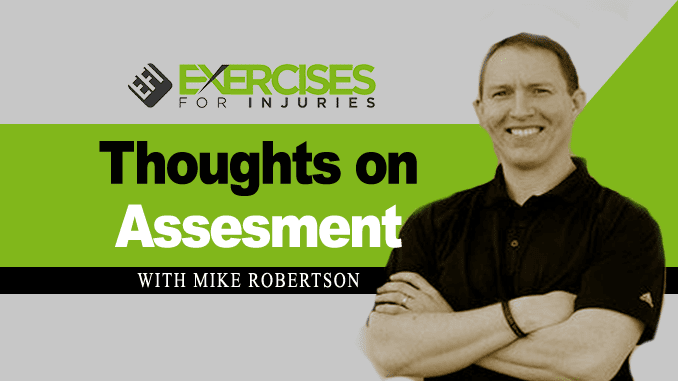
Assessment is an essential part of fitness training. It gives you a baseline for where you’re starting from and shows you how far you’ve come along the way. It helps spot potential issues hindering your progress, including health conditions or nutritional deficiencies. By assessing your client’s current state of health, you’ll give yourself the best chance of achieving your client’s goals. There are many ways to evaluate health and fitness levels, including blood, body composition analysis, and aerobic capacity testing. While it’s not always necessary to undergo such extensive testing, it may be a good idea if you’re trying to lose weight or have a history of heart disease in your family. Regardless of how you assess your fitness level, taking the time to do it is essential. With proper Assessment, you can ensure that you’re on track to reaching your fitness goals and staying healthy.
Below are some keys to Remember when Assessing Your Client with Mike Robertson
1. Why are assessments so critical to the fitness professional?
Assessments are an integral part of a successful fitness program. Regardless of the type of program, assessments are an essential tool to help determine an individual’s needs, goals, and strengths. Through these assessments, a fitness professional can determine the exercises and activities the individual needs to do to reach their goals. If an assessment is only one component of a comprehensive program, it can help clients identify their strengths and weaknesses and tailor the workouts to suit their needs. Assessments can also help identify underlying health issues and any mental or emotional barriers that may interfere with progress. For example, if you’re working with a new client who has never worked out, you must thoroughly assess their physical abilities and limitations. You might also want to do a psychological assessment to see whether mental or emotional barriers may interfere with progress. The goal of an assessment is to identify what areas need improvement.
2. What kinds of assessments that Mike goes through?
Different fitness assessments can be undertaken, depending on the type of individual and their specific needs. For example, a personal trainer may wish to conduct a complete evaluation of an individual’s fitness levels, including body composition analysis and strength testing, to create a bespoke training plan. Alternatively, a fitness coach may want to assess whether an individual is ‘fit’ enough to participate in a specific exercise class.
Assessment through static posture shot, gait assessment, Manual muscle testing, and flexibility or stability on a table. Movement-based tests like overhead squats, lunges, and push-ups. If they are athletes, let them watch the game footage or play their sport because observing them in the field will give us more information to help us develop better programming for them.
We can develop a much more comprehensive program for our clients by giving them static, gait, or dynamic assessments.
3. The boundary a fitness professional has when assessing a client
Boundary issues are always present in any relationship between two people. They can be tricky to navigate when the participants come from very different backgrounds. A fitness professional can understand various physical, mental, and emotional issues. However, it is important not to cross the line into diagnosing or treating ailments. If a client is experiencing symptoms that seem out of the ordinary, it may be worth seeking a medical opinion or referring them to a mental health professional. While it is essential to maintain professional boundaries with clients, it is also necessary to be flexible and open-minded. It is crucial to remember that no two people are the same and that there is no such thing as a “standard” client. As such, it is vital to accept that clients come from a wide range of backgrounds and have unique needs and expectations. Taking a step back and seeing things more objectively can help.
4. Tips for your Assessment
Be thorough with your Assessment by giving them as many tests as necessary to get all the information you need to create the best training program for the client specific to their needs and capabilities. Use all the available tools, but make sure your Assessment is thorough and necessary.
5. The number one trap fitness professionals fall into when assessing a client.
The first trap fitness professionals fall into when assessing a client is assuming that other people have the same goals. Many fitness professionals come from a training background. They have seen their fair share of clients with different body types and shapes, but they are often hesitant to advise anyone outside their own experience. This can be a big problem because it prevents them from being able to reach more people. There is no “one-size fits all” solution when it comes to exercise, and if you’re not open to hearing what your client wants and needs, you could leave some of them behind. It’s hard to motivate someone if you keep telling them what they should be doing, so make sure you listen and talk. Also, remember that everybody is different, so there may be modifications or other considerations depending on your client’s needs.
CLICK HERE to hear the interview with Mike Robertson on Fitness Assessment
If you want more information about Mike Robertson, he will present a 16-hour course/seminar in Vancouver, BC, Canada, in December.
You can get the details right here:
- Bulletproofing Your Lower Back with Mike Robertson – Saturday, December 11, 2010
- Bulletproofing Your Client’s Knees with Mike Robertson – Sunday, December 12, 2010
I have other articles and interviews with Mike Robertson; you can check them out here:
Rick Kaselj, MS




